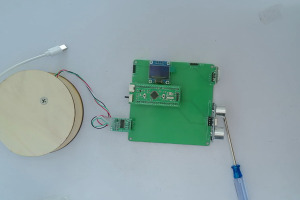设计说明书
总字数:14000+
摘 要
随着健康意识的提高,健康称已成为人们日常生活中不可或缺的一部分。本研究设计了一种基于STM32F103C8T6单片机的健康称系统,该系统通过超声波传感器获取用户的身高信息,利用HX711模块精确测量用户的体重。在此基础上,系统能够自动计算用户的BMI值,并根据BMI值判断用户的体重状况。当BMI低于18.5时,系统判定为体重过轻;当BMI在18.5至23.9之间时,系统判定为体重正常;当BMI高于24时,系统判定为体重过重。系统采用OLED显示模块,能够实时显示用户的身高、体重以及BMI值,方便用户直观了解自身健康状况。此外,系统还集成了WiFi模块,支持将监测数据实时传输至手机端,使用户能够随时随地关注自己的健康数据。实验结果表明,该健康称系统具有测量准确、操作简便、功能丰富等优点,为人们的健康管理提供了有力支持。
关键词:STM32F103C8T6;超声波传感器;健康称;BMI计算;WiFi传输
ABSTRACT
With the improvement of health awareness, health has become an indispensable part of people’s daily lives. This study designed a health scale system based on STM32F103C8T6 microcontroller. The system obtains the user’s height information through ultrasonic sensors and accurately measures the user’s weight using the HX711 module. On this basis, the system can automatically calculate the user’s BMI value and determine the user’s weight status based on the BMI value. When the BMI is below 18.5, the system determines that the weight is underweight; When the BMI is between 18.5 and 23.9, the system determines that the weight is normal; When the BMI is higher than 24, the system determines it as overweight. The system adopts OLED display module, which can display the user’s height, weight, and BMI value in real time, making it convenient for users to intuitively understand their own health status. In addition, the system also integrates a WiFi module that supports real-time transmission of monitoring data to mobile devices, allowing users to monitor their health data anytime and anywhere. The experimental results show that the health scale system has the advantages of accurate measurement, easy operation, and rich functions, providing strong support for people’s health management.
Key words: STM32F103C8T6;Ultrasonic sensor;Health scale;BMI calculation;WiFi transmission
目□□录
摘 要
ABSTRACT
1□绪论
1.1□选题背景及意义
1.2□国内外研究现状
1.2.1□国内研究现状
1.2.2□国外研究现状
1.3□研究方法与内容
1.4□章节介绍
2□总体方案介绍
2.1□设计任务及要求
2.2□总体结构设计
2.3□模块核心器件
2.3.1□单片机控制
2.3.2□超声波传感器获取身高值
2.3.3□HX711传感器获取体重值
2.3.4□无线通信
2.4□本章小结
3□硬件系统设计
3.1□主控模块设计
3.2□超声波模块设计
3.3□称重模块设计
3.4□显示模块设计
3.5□WIFI通信模块设计
3.6□本章小结
4□软件系统设计
4.1□主程序设计
4.2□超声波检测模块子流程设计
4.3□称重模块子程序设计
4.4□无线通信模块程序设计
4.5□手机APP设计
4.6□本章小结
5□系统调试与功能实现
5.1□仿真测试
5.1.1□Keil5简介
5.1.2□Proteus简介
5.1.3□程序导入
5.1.4□上电运行
5.1.5□功能测试
5.2□实物测试
5.2.1□实物制作
5.2.2□系统功能测试
5.3□本章小结
结论
参考文献
致□□谢
附录
购买后可查看具体内容!

